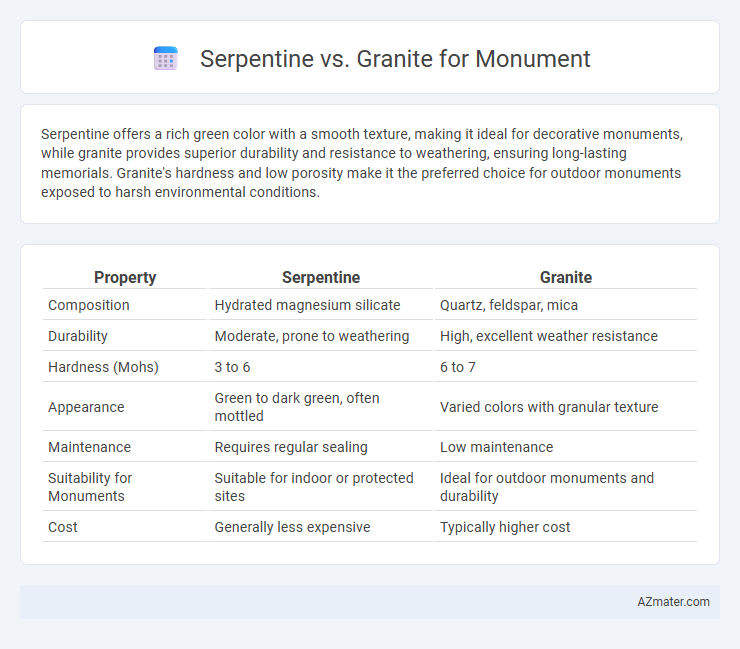Serpentine offers a rich green color with a smooth texture, making it ideal for decorative monuments, while granite provides superior durability and resistance to weathering, ensuring long-lasting memorials. Granite's hardness and low porosity make it the preferred choice for outdoor monuments exposed to harsh environmental conditions.
Table of Comparison
| Property | Serpentine | Granite |
|---|---|---|
| Composition | Hydrated magnesium silicate | Quartz, feldspar, mica |
| Durability | Moderate, prone to weathering | High, excellent weather resistance |
| Hardness (Mohs) | 3 to 6 | 6 to 7 |
| Appearance | Green to dark green, often mottled | Varied colors with granular texture |
| Maintenance | Requires regular sealing | Low maintenance |
| Suitability for Monuments | Suitable for indoor or protected sites | Ideal for outdoor monuments and durability |
| Cost | Generally less expensive | Typically higher cost |
Introduction to Serpentine and Granite
Serpentine is a greenish, metamorphic rock often appreciated for its rich texture and vibrant patterns, making it a unique choice for monuments with a distinctive aesthetic. Granite, a durable and coarse-grained igneous rock composed mainly of quartz, feldspar, and mica, is widely favored for its strength and longevity in monumental applications. Both stones offer distinct visual and physical properties that influence their suitability for different commemorative purposes.
Geological Origins and Properties
Serpentine originates from the metamorphic alteration of ultramafic rocks, predominantly composed of magnesium silicate minerals creating a unique greenish, often mottled appearance ideal for decorative monuments. Granite forms from the slow crystallization of magma beneath the Earth's surface, characterized by its coarse-grained texture and comprised mainly of quartz, feldspar, and mica, offering exceptional hardness and durability. The inherent density and low porosity of granite make it highly resistant to weathering, while serpentine's relative softness and susceptibility to chemical alteration affect its long-term preservation in outdoor environments.
Appearance and Color Variations
Serpentine features a distinctive green, black, and gold marbled appearance, often with a more varied and dramatic color palette that creates unique, eye-catching monuments. Granite offers a broader range of colors, including pink, white, gray, and black, with consistent speckled patterns and a polished finish that highlights its natural crystalline structure. Both stones provide durable options, but serpentine's rich, multicolored veining contrasts with granite's classic, uniform look, influencing monument aesthetics and customization choices.
Durability and Weather Resistance
Serpentine, while visually striking with its rich green hues, is less durable and more prone to weather-related erosion compared to granite, making it less suitable for long-term monument use. Granite is renowned for its exceptional hardness and resistance to weathering, maintaining structural integrity and aesthetic appeal even under harsh environmental conditions. For monuments, granite's superior durability and weather resistance ensure longevity and minimal maintenance over time.
Maintenance and Longevity
Serpentine is softer and more porous than granite, requiring more frequent sealing and careful cleaning to prevent staining and weathering on monuments. Granite's superior hardness and low porosity contribute to its exceptional durability, making it highly resistant to scratches, erosion, and discoloration over time. Monuments crafted from granite typically demand less maintenance and retain their structural integrity and polished appearance far longer than those made from serpentine.
Cost Comparison
Serpentine monuments typically cost less than granite due to lower quarrying and processing expenses, making them a budget-friendly option for memorials. Granite, while more expensive, offers greater durability and a polished finish that justifies its higher price point for lasting monuments. Pricing for serpentine ranges around $30-$50 per square foot, whereas granite often costs between $50-$100 per square foot, reflecting the material's strength and aesthetic appeal.
Ease of Carving and Detailing
Serpentine stone offers superior ease of carving and intricate detailing compared to granite due to its softer texture and smoother grain, making it ideal for fine sculptural work on monuments. Granite's hardness and coarse grain pose challenges for detailed carving, requiring specialized tools and more labor-intensive processes. Sculptors often prefer serpentine for elaborate designs, while granite is chosen for durability and longevity in monument construction.
Environmental Impact
Serpentine and granite differ significantly in their environmental impact when used for monuments. Serpentine, a metamorphic rock, often involves less intensive quarrying processes but can release asbestos fibers during cutting, posing health and environmental risks. Granite quarrying produces substantial dust and requires significant energy consumption, yet its durability reduces the need for frequent replacement, balancing its environmental footprint over time.
Popular Uses in Monument Construction
Serpentine is favored in monument construction for its rich green hues and unique marbling, making it ideal for decorative plaques and intricate carvings, while granite's durability and resistance to weathering suit it for heavy-use monuments such as headstones and public memorials. Granite's wide availability and range of colors from black to pink allow for versatile design options and long-lasting tributes. The choice between serpentine and granite depends on the desired aesthetic and environmental resilience required for the monument.
Choosing the Right Stone for Your Monument
Serpentine offers unique deep green hues with a smooth texture, making it ideal for monuments that emphasize aesthetic elegance and uniqueness, while granite provides superior durability and resistance to weathering, ensuring long-lasting preservation of inscriptions. When choosing the right stone for your monument, consider the local climate and desired maintenance level, as granite withstands harsh environments better than serpentine. The decision hinges on balancing the monument's visual appeal with practical longevity and environmental resilience.

Infographic: Serpentine vs Granite for Monument
 azmater.com
azmater.com